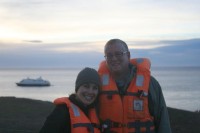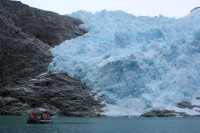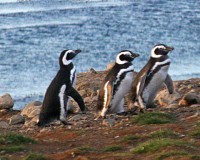Mon 14 Apr 2008

The archipelago of Tierra del Fuego (“Land of Fire” in Spanish), so named by Ferdinand Magellan when he spotted fires on the shore ((These fires were lit by the Yamana Indians who lived in the area. Unfortunately, these native Indians were quickly wiped out when the first Europeans arrived in the area, carrying with them diseases such as smallpox that the immune systems of the Yamanas were not equipped to fight.)) as he sailed through the area in the early 16th century, is located in the southernmost point of Patagonia. ((Patagonia–it’s not just a brand of clothing–is the name of the region of southern South America controlled by Argentina and Chile and renowned for its wild, harsh and gorgeous geography.)) The area is rich in history. After Christopher Columbus and other explorers had discovered the Americas and determined that it was not part of Asia, the next task was to find a way to get around the Americas and gain quick access to the riches of the Spice Islands and the rest of Asia ((This was especially important to the Spanish after the Portuguese had gained exclusive rights to the sailing route from Europe to Asia around the tip of Africa.)).
Ferdinand Magellan signed up for the mission and set off in search of the elusive route, eventually finding a narrow waterway that became known as the Strait of Magellan. The exploration did not end there. Due to the difficulty of navigating the narrow Strait and the expensive tolls levied by the various owners of the passageway, sailors started looking for an alternative route around South America. This was eventually achieved as sailors continued south and found the last piece of land at Cape Horn in 1616, enabling them to circle Cape Horn and avoid the Strait of Magellan. This similarly dangerous route was used for years until the Panama Canal was completed in 1914, providing a much more direct route from Europe to Asia.

Intent on exploring this area, Shanna and I signed up for a 4 day cruise on the Mare Australis, a ship that departed from Ushuaia, Argentina, sailed south to Cape Horn and then back north through the Fjords of Fuegia until it reached the Strait of Magellan and the historic city of Punta Arenas, Chile. Never having been on a cruise ship before, I must admit that I feared the ship would consist solely of senior citizens intent on spending their days playing shuffleboard or perhaps bridge, dining at 5 pm and having a toddy at 7 pm before calling it a night. Our fears were quickly allayed when we received the cruise orientation in which the speaker referred to the cruise as an “expedition.”

The first port of call was the historic Cape Horn. After boarding a “zodiac” boat and speeding ashore while wearing some very sexy lifejackets, we stepped on the small island and hiked to the only two points of interest. First, there is a huge statue of an albatross (a very large bird native to the area) built to commemorate the thousands of sailors who’ve died while trying to round the Cape. Second, there is a small lighthouse and home where a member of the Chilean Navy and his family resides ((We were told that each family spends one year at this remote location, before the next family moves in. The family that is currently there greeted the visitors and explained that they would be leaving before their year was up because the wife was pregnant. Suspicion arose that their family planning was accelerated as a brilliant way of getting early reprieve from this harsh land.)). While the landscape was treeless and fairly barren, there was a mystical quality about walking on the southernmost point in our world.
Later that day, we alighted on a remote island and hiked to the top of a large hill to view a spectacular sunset. Our kinship with nature was in full force the next two days as we sailed in the zodiacs to view a fjord with its gushing waterfalls and blue-iced glaciers, followed by a visit to Magdalena Island in the Strait of Magellan the next morning.

Magdalena Island is famous for its part-time inhabitants–penguins. Each spring, thousands of penguins return to the island to mate, raise new baby penguins and molt before returning to the ocean for a six-month swim beginning in the Fall. During the peak penguin season, the penguins cover virtually the entire island. As our visit coincided with the end of the season, only a few thousand penguins remained, most of whom were still slumbering in their nests as we hiked around the island.
Overall, the cruise was a pleasant surprise. The ship was fairly new with spacious cabins, comfortable common areas and very good food. Each day, there were a couple of informative lectures about the area, its history and its wildlife. And, yes, they had bingo one night…which of course we had to play. Sometimes you just have to adapt to your environment.
[embedplusvideo height=”350″ width=”450″ editlink=”http://bit.ly/1mFI3iW” standard=”http://www.youtube.com/v/EtJJ-0N5tcI?fs=1″ vars=”ytid=EtJJ-0N5tcI&width=450&height=350&start=&stop=&rs=w&hd=0&autoplay=0&react=1&chapters=¬es=” id=”ep3688″ /]
[embedplusvideo height=”350″ width=”450″ editlink=”http://bit.ly/1mFIGZO” standard=”http://www.youtube.com/v/2by-NsBgsAQ?fs=1″ vars=”ytid=2by-NsBgsAQ&width=450&height=350&start=&stop=&rs=w&hd=0&autoplay=0&react=1&chapters=¬es=” id=”ep3726″ /]
Be sure to pick up a copy of Bruce Chatwin’s “In Patagonia” for an interesting take on the region. He’s quite controversial in Argentina and Chile for having taken a few liberties with the facts. No need to let the facts get in the way of a good story!